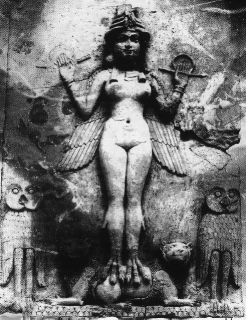
LILITH--MESOPOTAMIA ©JBL
| African Goddesses | Asian Goddesses | Central American Goddesses |
| Eastern European Goddesses | Egyptian Goddesses | Graeco-Roman Goddesses |
| Himalayan Goddesses | Hindu Goddesses | Near Eastern Goddesses |
| North American Goddesses | Northern European Goddesses | Oceanic Goddesses |
| South American Goddesses | South-East Asian Goddesses | Western European Goddesses |
The names of many Goddesses have been inherited by the contemporary Western world as relics, dusty curiosities to be occasionally dusted off, displayed for the amusement, and then put away again. The power of these names, the power of the entities which once claimed these names, has been forgotten. The temples are in ruins, the prayers forgotten, the devotion of the faithful considered odd, heathenish, superstitious. The sacred stories have been relegated to history texts and children's books; the stories are no longer sacred, but interesting anthropological specimens to be studied and dissected for what they can reveal about the ancients; or, they are fables, legends, exciting tales to entertain ingenuous children.
And so the stories remained, black ink on white paper, stripped of much of their energy and vitality, truly alive to only an imaginative few. But remain they did, and now they are being reclaimed.
Whether one considers the ancient Goddesses living entities, or manifestations of a Unitary One, or psychological archetypes, or models of feminine potential, is irrelevant: They are re-entering our modern lives, and bringing with Them all of Their vitality, anger, power, sensuality, charisma and wisdom.
The reasons for Their return are many. The Goddesses call to the dissatisified, those who have found wanting mainstream Western religions, political institutions and even whole cultures--all male-centered. Many find the religions of their mothers and grandmothers dissatisfying; perhaps it is the missing female element which makes the religion so; perhaps it is the position of man over woman (literally and figuratively); perhaps it is the emphasis on the spiritual over the physical and mental, the human over the animal and natural, the logical over the illogical, the rational over the intuitive, the implicit Otherness of woman and her experiences.
Women's fight for political and economic justice has also sparked the return of the Goddesses; as women struggled with institutions and individuals, they were often confronted with established, patriarchal, religiously-justified images of Woman as weak, apathetic, mild, and so on. Some women sought to counter these established images and attitudes, and so they searched through tomes of religion and history and mythology for Matrons of their own. They found buried and misinterpreted and reinterpreted stories of Woman as warrior, scholar, Matriarch and Goddess. Some of these images were found within the mainstream religions: Eve, Sarah, Hagar, Rebecca, Rachel, Leah, Tamar, Abigail, Deborah, Judith, Jael, Esther, Miriam, Hannah; Anne, Elizabeth, the Virgin Mary, Mary Magdalene, Thekla, tens of hundreds of Christian Saints; Khadijah, A'iasha, Fatimah, the many Saints of the Sufi. As the women's rights struggle spread to other parts of the world, the women of Africa, Asia and South America also turned to books of religion and mythology and folklore for images of strong, determined women.
Simultaneous with the growth of the women's rights movement has been the surge of interest in women's studies and herstory; that is, women's relationships with men in the past and present, with children, with one another, and their perceptions of the world and of themselves. Each aspect of the women's studies movement contributes to the ever-growing picture of women's places in and contributions to human civilization. Some studies look broadly at women's economic contribution and place, her social standing, and attitudes about her. Other studies focus on much narrower topics, such as women in the internment camps of World War II America, or lesbians in Medieval England, or Jewish healers in Byzantium. Still other studies have looked at the relationship between women and religion, both ancient and modern; they have studied the change from Goddess to God, read the myths of rape and murder, studied the laws which limited women's rights, translated the theological tracts which listed her vices and virtues; and in so doing have uncovered many lost tales of heras*, scholars, healers and Goddesses.
I tell here the tales of a few of these Goddesses. Some are well-known only to academics, others are familiar to laywomen and -men everywhere. The temples and sacred sites of some of these Goddesses long ago were destroyed and fell to ruin, while others are centers of tourism. Other temples and sacred sites--particularly in the East and South, where the Goddesses were never forgotten--are still the site of devout pilgrimage. Much of the information presented here can be found on other sites along the Highway or in the college classroom or on the shelves at the library. Rather than present simple facts, then, I have endeavoured to return to life these ancient names through the art of storytelling. Her name and a brief biography can be found at the site of each Goddess, followed by a short story detailing Her attributes, relationships, myths and areas of expertise. I hope the reader finds this a welcome change from the usually sterile recitation of facts and attributes.
As always, please mail me, as any criticism or suggestion is welcome, and any submission which I include will be duly credited.
*Hera is actually the correct feminine form of "hero," not heroine or shero. Herais is another correct form.
Back to Table of Goddesses
Back to Introduction
Back to Descent of the Gods
To Muses